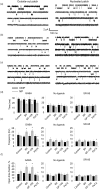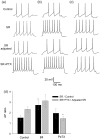Feature Article: Selective modulation of tonically active GABAA receptor functional subgroups by G-proteins and protein kinase C
- PMID: 30205722
- PMCID: PMC6434461
- DOI: 10.1177/1535370218800980
Feature Article: Selective modulation of tonically active GABAA receptor functional subgroups by G-proteins and protein kinase C
Abstract
Here we study intracellular mechanisms which regulate inhibitory signaling delivered through continuously (tonically) open ionotropic receptors of γ-aminobutyric acid (GABA) of dentate gyrus granule cells (DGCs). We found that, apart of classical GABA-A receptors (GABAARs) which can be activated by GABA binding, a significant part of tonic inhibitory current is delivered by newly discovered spontaneously opening GABAARs (s-GABAARs), which enter active state without binding of GABA. We have also found that conventional GABAARs and s-GABAARs are regulated by different intracellular mechanisms, which may overlap and thus induce various signaling repercussions. Our results demonstrate that s-GABAARs play a key role in the mechanism that implements DGCs functional role in the brain. On top of that, since regulatory mechanisms under study are affected in a number of pathological states, our results may have broad implications for treatment of neurological disorders.
Keywords: G-proteins; Spontaneously opening GABAA receptors; action potential generation; protein kinase C; tonic inhibitory current.
Figures




Similar articles
-
The Functional Role of Spontaneously Opening GABAA Receptors in Neural Transmission.Front Mol Neurosci. 2019 Mar 28;12:72. doi: 10.3389/fnmol.2019.00072. eCollection 2019. Front Mol Neurosci. 2019. PMID: 30983968 Free PMC article.
-
Spontaneously opening GABAA receptors play a significant role in neuronal signal filtering and integration.Cell Death Dis. 2018 Jul 24;9(8):813. doi: 10.1038/s41419-018-0856-7. Cell Death Dis. 2018. PMID: 30042389 Free PMC article.
-
Enduring changes in tonic GABAA receptor signaling in dentate granule cells after controlled cortical impact brain injury in mice.Exp Neurol. 2016 Mar;277:178-189. doi: 10.1016/j.expneurol.2016.01.005. Epub 2016 Jan 6. Exp Neurol. 2016. PMID: 26772635
-
Tonically active GABA A receptors: modulating gain and maintaining the tone.Trends Neurosci. 2004 May;27(5):262-9. doi: 10.1016/j.tins.2004.03.005. Trends Neurosci. 2004. PMID: 15111008 Review.
-
GABAergic regulation of the HPA and HPG axes and the impact of stress on reproductive function.J Steroid Biochem Mol Biol. 2016 Jun;160:196-203. doi: 10.1016/j.jsbmb.2015.11.019. Epub 2015 Dec 9. J Steroid Biochem Mol Biol. 2016. PMID: 26690789 Free PMC article. Review.
Cited by
-
The Functional Role of Spontaneously Opening GABAA Receptors in Neural Transmission.Front Mol Neurosci. 2019 Mar 28;12:72. doi: 10.3389/fnmol.2019.00072. eCollection 2019. Front Mol Neurosci. 2019. PMID: 30983968 Free PMC article.
References
-
- Glykys J, Mody I. Activation of GABAA receptors: views from outside the synaptic cleft. Neuron 2007; 56:763–70 - PubMed
-
- Hodge CW, Mehmert KK, Kelley SP, McMahon T, Haywood A, Olive MF, Wang D, Sanchez-Perez AM, Messing RO. Supersensitivity to allosteric GABA(A) receptor modulators and alcohol in mice lacking PKCepsilon. Nat Neurosci 1999; 2:997–1002 - PubMed
Publication types
MeSH terms
Substances
Grants and funding
LinkOut - more resources
Full Text Sources
Other Literature Sources

